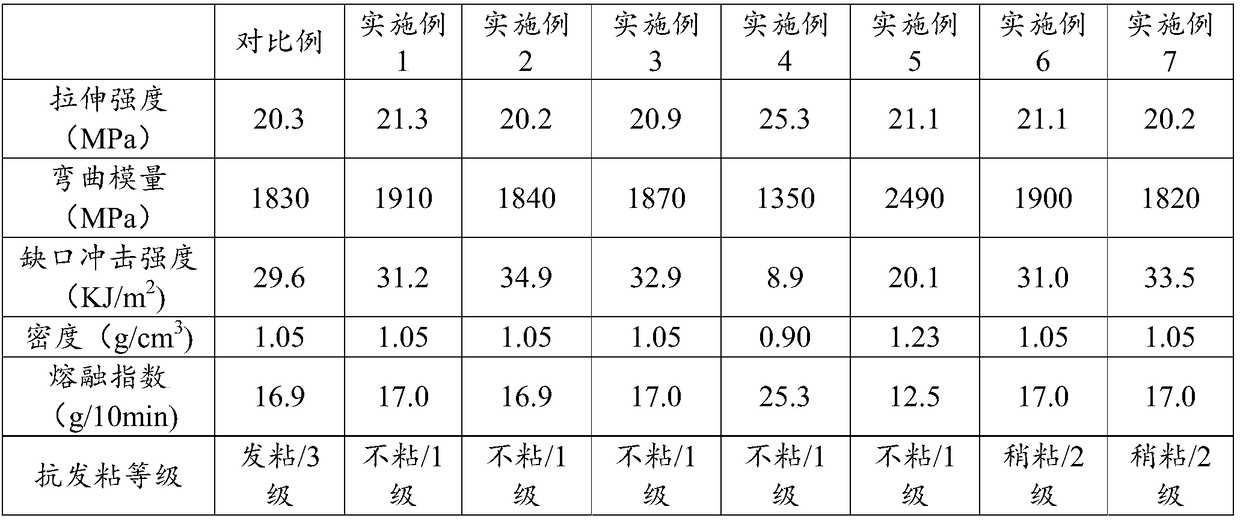Application of nucleating agent for lowering separation viscidity of polypropylene composite material
A composite material and nucleating agent technology, applied in the field of polypropylene materials, can solve the problems of inapplicability, reduce self-polarity, easy agglomeration of the matrix, etc., and achieve the effects of inhibiting the precipitation of additives, solving the problem of stickiness, and simple operation.
- Summary
- Abstract
- Description
- Claims
- Application Information
AI Technical Summary
Problems solved by technology
Method used
Image
Examples
Embodiment 1
[0034] An embodiment of the polypropylene composite material of the present invention, the polypropylene composite material described in this embodiment is prepared by the following method:
[0035]Weigh 67 parts of polypropylene, 20 parts of talcum powder with an average particle diameter of 3 μm, 10 parts of ethylene-octene polymer, 0.25 part of antioxidant 1010, 0.25 part of antioxidant 168, 2.5 parts of auxiliary agent (including: 0.25 part Light stabilizer, 0.25 parts of lubricant and 2 parts of anti-scratch agent) and 0.5 part of sorbitol α-nucleating agent; put the above raw materials into a high-speed mixer and stir fully to obtain a premix, and place the premix in a twin-screw The main feeding port of the extruder is melted and extruded, granulated and dried to obtain the polypropylene composite material.
[0036] The melt extrusion conditions of the twin-screw extruder are: the temperature of the first zone is 90°C, the temperature of the second zone is 200°C, the te...
Embodiment 2
[0038] An embodiment of the polypropylene composite material of the present invention, the polypropylene composite material described in this embodiment is prepared by the following method:
[0039] Weigh 67 parts of polypropylene, 20 parts of talcum powder with an average particle diameter of 3 μm, 10 parts of ethylene-octene polymer, 0.25 part of antioxidant 1010, 0.25 part of antioxidant 168, 2.5 parts of auxiliary agent (including: 0.25 part light stabilizer, 0.25 parts of lubricant and 2 parts of anti-scratch agent) and 0.5 parts of rare earth β-nucleating agent; the above raw materials are put into a high-speed mixer and fully stirred to obtain a premix, and the premix is placed in a twin-screw extruder The main feeding port of the machine is melted and extruded, granulated and dried, and the polypropylene composite material is obtained.
[0040] The melt extrusion conditions of the twin-screw extruder are: the temperature of the first zone is 90°C, the temperature of ...
Embodiment 3
[0042] An embodiment of the polypropylene composite material of the present invention, the polypropylene composite material described in this embodiment is prepared by the following method:
[0043] Weigh 67 parts of polypropylene, 20 parts of talcum powder with an average particle diameter of 3 μm, 10 parts of ethylene-octene polymer, 0.25 part of antioxidant 1010, 0.25 part of antioxidant 168, 2.5 parts of auxiliary agent (including: 0.25 part Light stabilizer, 0.25 parts of lubricant and 2 parts of anti-scratch agent), 0.25 parts of sorbitol type α nucleating agent and 0.25 part of rare earth type β nucleating agent; put the above raw materials into a high-speed mixer and fully stir to obtain a premix , putting the premixed material in the main feeding port of the twin-screw extruder for melt extrusion, granulation and drying to obtain the polypropylene composite material.
[0044] The melt extrusion conditions of the twin-screw extruder are: the temperature of the first zo...
PUM
| Property | Measurement | Unit |
|---|---|---|
| melt flow index | aaaaa | aaaaa |
| particle diameter | aaaaa | aaaaa |
| melt flow index | aaaaa | aaaaa |
Abstract
Description
Claims
Application Information
 Login to View More
Login to View More - R&D
- Intellectual Property
- Life Sciences
- Materials
- Tech Scout
- Unparalleled Data Quality
- Higher Quality Content
- 60% Fewer Hallucinations
Browse by: Latest US Patents, China's latest patents, Technical Efficacy Thesaurus, Application Domain, Technology Topic, Popular Technical Reports.
© 2025 PatSnap. All rights reserved.Legal|Privacy policy|Modern Slavery Act Transparency Statement|Sitemap|About US| Contact US: help@patsnap.com

